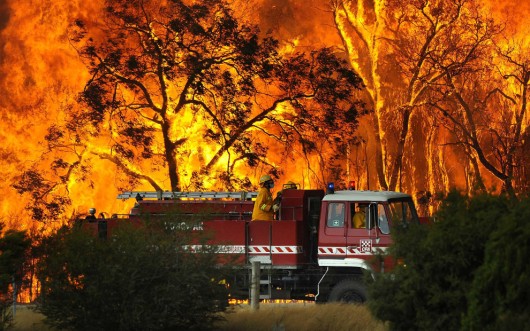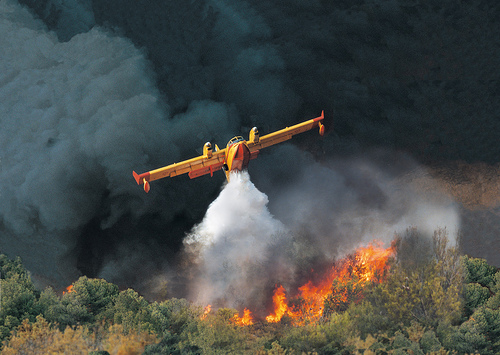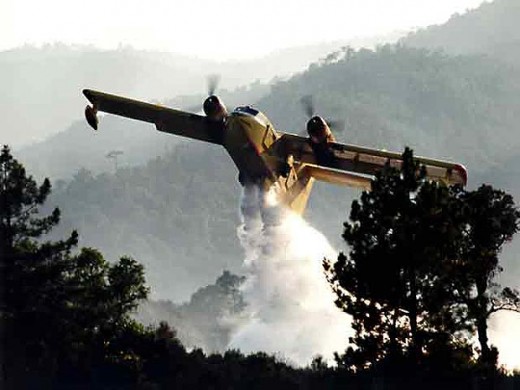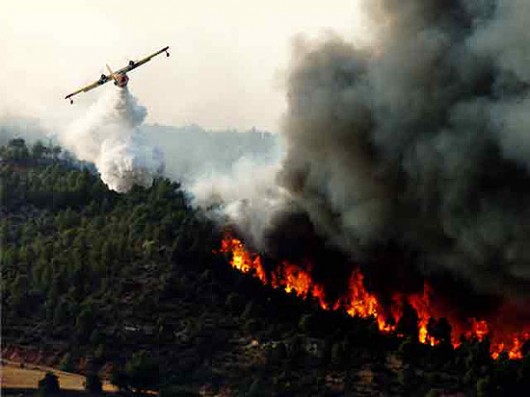‘Bushfire Response’: national investment due
Friday, November 11th, 2011.
Standby Bombardier 415’s strategically placed during Australian summers – a clear advantage over road-limited fire trucks – but try telling Australia state governments at budget time and they only cry poor. But then state government bushfire response record is littered with recurring tragedy and failure – Victoria, Canberra, Perth Hills, Blue Mountains, Eyre Peninsula….
We need to dig deeper if we are serious about the bushfire threat, and this doesn’t mean just more charity to prop up the existing but failing system, as Prime Minister Rudd seems to perpetuate. This goes beyond the Victorian Bushfires. Under-resourcing is a fundamental problem with Australian bushfire management nationally.
The bushfire problem is only going to get worse given the trend toward hotter summers, prolonged droughts, climate change, arsonists and millions of houses now situated in bushfire prone areas. The answer is not to destroy vast swathes of bushland, which embers jump anyway sometimes spotting beyond 10km ahead of a fire front.
Detection, response and suppression are the measures of firefighting success criteria. Yet to adequately perform these, current bushfire management remains chronically under-resourced by all levels of government across Australia.
A fleet of Bombardier 415s (formerly Canadair CL-415) is a cost effective proactive investment in bushfire response and without doubt preferable to the $2 billion economic cost of Victoria’s 2009 bushfire catastrophe, ‘after the fact’.
.
Check this out: ^http://www.aerospace-technology.com/projects/bombardier_415/bombardier_4152.html
.
But also more manoeuvrable water-bombing rotary-wing aircraft like the Erikson Aircrane plus the dropping in of RAFT crews also deserve consideration particularly in rugged terrain, where Bombardiers would not be able to achieve water-bombing runs low enough to be effective.
 Remote Ignitions: Prompt airborne suppression simply works!
Remote Ignitions: Prompt airborne suppression simply works!
.
The cultural problem is that bushfire management is typically fire-truck centric in its thinking, planning and response. And beware of pollies and their devoted fans lobbying red herrings and porkies to try to stimie investigation into these options, when really the debate is simply one of cost.But research needs to precede any investment.
 A fire truck moves away from out of control flames from a bushfire in the Bunyip Sate Forest near the township of Tonimbuk, 125 kilometers (78 miles) west of Melbourne, Saturday, Feb. 7, 2009. Walls of flame roared across southeastern Australia, razing scores of homes, forests and farmland in the sunburned country’s worst wildfire disaster in a quarter century. (Source: AP Photo, ^http://archive.boston.com/bigpicture/2009/02/bushfires_in_victoria_australi.html)
Fire trucks exposed to remote wildfire? What OH&S standard would permit this operation outside volunteer rural fire fighting?
A fire truck moves away from out of control flames from a bushfire in the Bunyip Sate Forest near the township of Tonimbuk, 125 kilometers (78 miles) west of Melbourne, Saturday, Feb. 7, 2009. Walls of flame roared across southeastern Australia, razing scores of homes, forests and farmland in the sunburned country’s worst wildfire disaster in a quarter century. (Source: AP Photo, ^http://archive.boston.com/bigpicture/2009/02/bushfires_in_victoria_australi.html)
Fire trucks exposed to remote wildfire? What OH&S standard would permit this operation outside volunteer rural fire fighting?
.
Australia’s peak bushfire research organisation, Bushfire CRC, in its August 2006 report on the merits of aerial suppression made the following key findings:
.
- Aerial suppression can be effective in providing support to ground crews and improving the probability of first attack success by 50 percent or more. (so relies on fast detection of ignitions)
- For an aircraft to provide effective assistance it must be available at call, rapidly dispatched with minimal travel time and with logistical systems in place.
- Air operations effectively integrated into the incident management structure and competent personnel are needed to be available to direct the operations for good outcomes.
- The use of ground resources with initial aerial support is the most economically efficient approach to suppression.
- The use of aircraft for first attack until ground resources reach the fire produces the best suppression outcome.
- Large fixed wing air tankers such as a DC 10 are at a cost disadvantage. This is particularly the case for first attack when fires are small and where water drop accuracy is required. (…But no-one could argue that Victoria is now at a cost disadvantage without them..the economic bill alone is $2 Billion, which excludes the psychological, social and ecological costs).
.
The airborne response to ignition suppression is just one strategy. The bushfire management solution is complex. To be effective in preventing a repeat of Victoria’s tragic and disgraceful 7-Feb-09, demands massive public investment and organisation at a level only national resources can muster. Don’t deny the legacy of Victoria’s 173 bushfire victims to be remembered as a recurring Armistice Day. It is unacceptable for governments to dismiss bushfire deaths as a fate of nature.
.
~ Tigerquoll, licensed commercial helicopter pilot, Suggan Buggan, Victoria.










